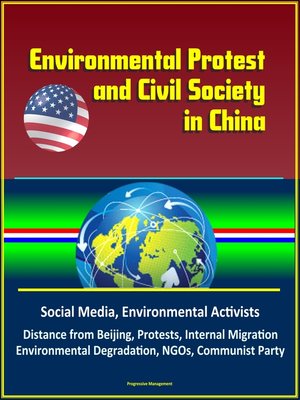Environmental Protest and Civil Society in China
ebook ∣ Social Media, Environmental Activists, Distance from Beijing, Protests, Internal Migration, Environmental Degradation, NGOs, Communist Party
By Progressive Management

Sign up to save your library
With an OverDrive account, you can save your favorite libraries for at-a-glance information about availability. Find out more about OverDrive accounts.
Find this title in Libby, the library reading app by OverDrive.



Search for a digital library with this title
Title found at these libraries:
| Loading... |
This excellent report has been professionally converted for accurate flowing-text e-book format reproduction. The leadership of the Chinese Communist Party (CCP) appears to have conceded that environmental issues are an area in which people may publicly challenge governmental and commercial actions; however, the movement does not yet appear to have undergone a significant, positive change of scale. This study proposes that, as the environmental movement continues to grow in size and legitimacy, the CCP will continue to co-opt these protests, using them to maintain its political monopoly. Yet, the increased dissemination of information may slowly allow China's civil society to coalesce and reach past local barriers. This research takes a closer look at environmental protests reported over a ten-year timespan, where they occurred, the issues protested, and whether they have affected Chinese society and politics. Due to an inability to access primary sources on Chinese protests, this study covers only some of the broad, macro-level trends visible through the lens of these secondary sources. Nevertheless, it concludes that the number of reported incidents of protest is growing, and their influence is felt throughout civil society.
The book takes a closer look at recent environmental protests, where they occurred, the issues protested, and if they have affected Chinese society and politics. Due to an inability to access primary sources on Chinese protests, this study uses secondary sources and Western news accounts. Unfortunately, this introduces an inherent bias to the sample. Because of these limitations, this study will only cover some of the broad, macro-level trends visible through the lens of these sources.
To understand the context of environmental activism in China, Chapter II traces the history of Chinese civil society and environmental activism from Mao through the current government. Chapter II will also briefly introduce a few of the key organizations and individuals that are prominent or influential in the Chinese environmental movement. Chapter III will provide a broad overview of environmental street protest trends through qualitative analysis of the collected dataset. Chapter IV will use the qualitative data of Chapter III as a foundation before offering a high-level analysis of the Chinese environmental movement within the larger context of social movement literature. Finally, the conclusion will speculate on the effect of environmental protests on Chinese Civil Society.
CHAPTER I - INTRODUCTION * A. CIVIL SOCIETY IN CHINA * B. LITERATURE REVIEW * 1. Social Movement Theory * 2. Environmental Activism and NGOs in China * C. PROBLEMS AND HYPOTHESES * D. METHODS AND OUTLINE * CHAPTER II - CHINESE CIVIL SOCIETY AND ENVIRONMENTAL LEGISLATION: 1980-2014 * A. CHINESE CIVIL SOCIETY AND THE EVOLUTION OF ENVIRONMENTAL REGULATIONS * 1. The Years 1980-1989 * a. Civil Society * b. Environmental Regulations * 2. The Years 1990-1999 * a. Civil Society * b. Environmental Regulations * 3. The Years 2000-2014 * a. Civil Society * b. Environmental Regulations * B. ENVIRONMENTAL ORGANIZATIONS, SOCIAL MEDIA, AND CASE STUDIES * 1. Environmental Activists * a. Environmental Non-government Organizations * b. Online Activists * 2. A Case Study * C. CONCLUSION * CHAPTER III - ENVIRONMENTAL PROTEST IN CHINA: BY THE NUMBERS * A. OVERARCHING TRENDS IN CHINESE ENVIRONMENTAL PROTESTS * 1. Data Characteristics * 2. Data Trends * B. PROTESTS IN COMPARISON TO DEMOGRAPHIC AND ECONOMIC DATA * 1. Distance from Beijing (Political Control) * 2. Internal Migration * 3. Levels of Environmental Degradation * 4. Economic Explanations * C. CONCLUSION * CHAPTER IV - CHINA'S...






